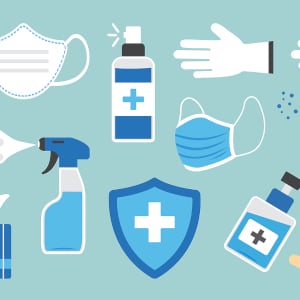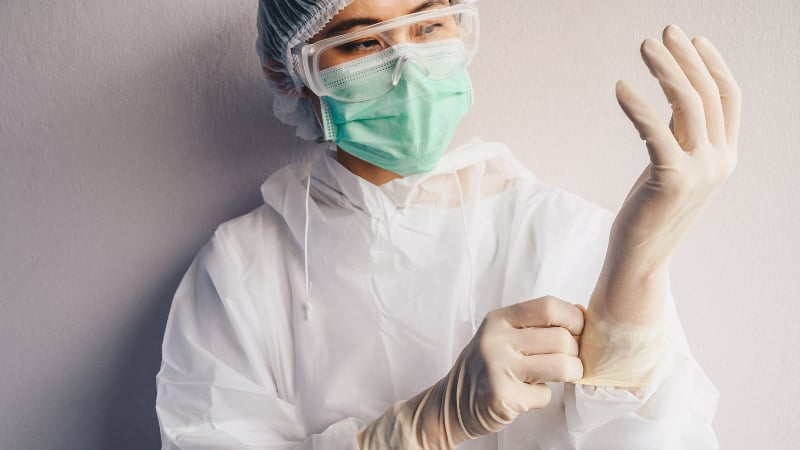Similar to legal malpractice suits, uncovered medi...
 Personal protective equipment (PPE) helps millions of employees stay safe at work every year. PPE, which includes everything from goggles to steel-toe boots, is an important aspect of any safety plan.
Personal protective equipment (PPE) helps millions of employees stay safe at work every year. PPE, which includes everything from goggles to steel-toe boots, is an important aspect of any safety plan.
When engineering and administrative controls are ineffective, the Occupational Safety and Health Administration (OSHA) requires all businesses use of personal protective equipment PPE to reduce employee exposure to dangers.
When defining PPE (hard hats, goggles, work boots, gloves, etc.), there can be a lot of ambiguity. For a given task, how much personal protective equipment PPE does an employee truly need? What kind of gloves should the employee wear? Is it necessary to clean the PPE after each use?
Because the field of safety management can be perplexing, we have compiled a list of frequent misunderstandings concerning PPE:
Regardless of how small or large the job or company is, the employer is always responsible for providing the necessary safety equipment. In fact, the law states that if a danger is detected, PPE must be readily available.
However, the requirements do not end there; employers must prominently display where the equipment is stored, as well as instructions on how to locate it if it is deemed required.
According to health and safety experts, both over-protection and under-protection can be equally deadly. Wearing too many layers may produce heat stress because of over-protection. After years of exposure to certain hazardous compounds, inadequate protection may result in persistent health problems.
The goal is to develop PPE that provides the best protection against industrial risks while also allowing the employee to be as comfortable as possible.
Leather gloves can be perforated and cannot prevent cuts. Leather is animal skin, no matter how thick it is, and just like human skin it can be cut, especially when moist. Employers should provide leather gloves with the optimum protection, dexterity, and tactile performance based on the worker’s unique job demands. Furthermore, workers must use caution when managing sharp objects and machinery.
Wearing the appropriate PPE for the work or the task at hand is merely the first step. PPE will only protect you if you wear it appropriately and according to the manufacturer’s instructions. For example, goggles will not protect your eyes if they are on top of your head, right?
Ensuring that all your staff or employees are properly instructed on how to wear PPE will limit misuse, and as a result, prevent unnecessary accidents. Be sure to regularly check that your PPE has not expired because expired PPE can be ineffective and hazardous.

Regardless of how big or small a project is, PPE should always be worn in the workplace if the job or function requires it. It is a harmful fallacy to assume that little jobs do not necessitate
PPE. Even if work or the project is just going to take a few minutes, a fall or spill can happen in an instant, resulting in a potentially fatal accident. It is vital to wear your safety equipment for any task conducted in the workplace, no matter how little it may appear.
PPE must be cleaned and stored correctly after each usage. If PPE is damaged it will not function properly and may expose the worker to injury and health risks. Any broken or worn-out PPE must be reported to managers/employees as soon as possible so that it can be replaced.
If you, as an employer, have determined that PPE is required for a task, you must ensure that it is worn. Encourage positive behavior by involving your staff in the process. Employees are significantly more likely to wear PPE if they feel it is comfortable. Always lead by example, and make sure you are wearing the proper safety gear.
PPE protects and shields workers from health and safety hazards while on the job and decreases employee exposure to hazards. Everything from slick, damp, floors, to loose, falling, debris might be a hazard.
When it comes to workplace safety, it is always better to be safe than sorry. If you believe even one of the myths listed above, it’s time to brush up on your personal protection equipment knowledge.
Leap | Carpenter | Kemps Insurance Agency provides Commercial Business Insurance, Employee Benefits, Life and Health Insurance, and Personal Insurance to all of California, including Merced, Atwater, Los Baños, Mariposa, Madera, Fresno, Modesto, Turlock, and Stockton. Contact us today.
Similar to legal malpractice suits, uncovered medi...
You get all the benefits and advantages of being a...
Natural disasters and crimes can impact a business...
Leap | Carpenter | Kemps Insurance Agency provides Commercial Business Insurance, Employee Benefits, Life and Health Insurance, and Personal Insurance to all of California, including Merced, Atwater, Los Banos, Mariposa, Madera, Fresno, Modesto, Turlock, and Stockton.
CA License Number 0646081 | Licensed to do business in California, Arizona, Hawaii, Idaho, Montana, Nevada, North Carolina, Oklahoma, Oregon, Virginia, West Virginia and Washington.
© Copyright 2023 Leap | Carpenter | Kemps Insurance Agency — Privacy Policy | Terms & Conditions.
Merced Office
3187 Collins Drive
Merced, CA 95348
Phone: (209) 384-0727
Additional Contacts
Toll Free: (800) 221-0864
Fax: (209) 384-0401